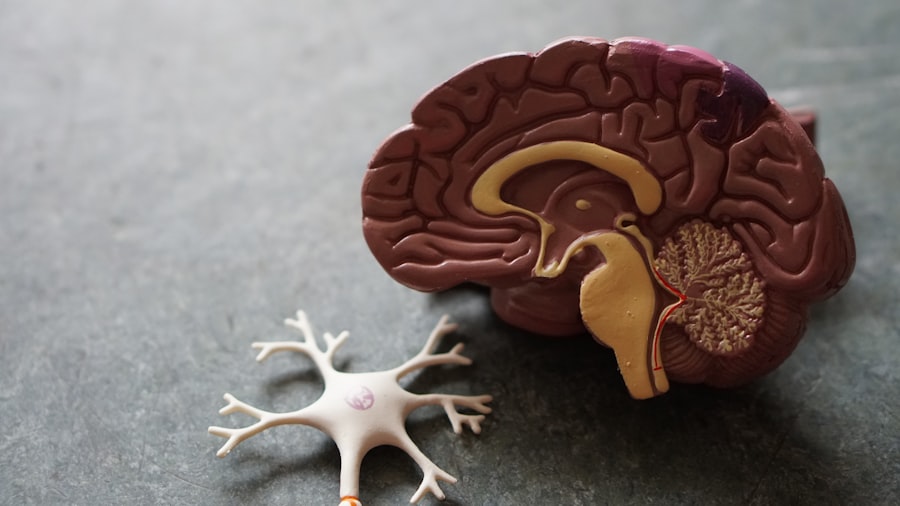Trauma is a complex and multifaceted experience that can leave lasting imprints on your brain and overall well-being. When you encounter a traumatic event, your brain’s response is immediate and instinctual, often triggering the fight-or-flight response. This reaction is governed by the amygdala, a small almond-shaped structure in your brain that processes emotions.
In the aftermath of trauma, the amygdala can become hyperactive, leading to heightened anxiety, fear, and emotional dysregulation. You may find yourself feeling constantly on edge, as if you are perpetually in danger, even in safe environments. Moreover, trauma can affect the prefrontal cortex, the area responsible for rational thinking and decision-making.
When this part of your brain is compromised, it can lead to difficulties in concentration, memory issues, and impaired judgment. You might struggle to make sense of your experiences or feel disconnected from reality. Understanding how trauma impacts your brain is crucial for recognizing the symptoms you may be experiencing and seeking appropriate help.
By acknowledging these changes, you can begin to take steps toward healing and recovery.
Key Takeaways
- Trauma can have a profound impact on the brain, affecting its structure and function.
- The brain’s neuroplasticity allows it to be rewired through various techniques, offering hope for trauma recovery.
- Therapy, mindfulness, and trauma-informed yoga and exercise are effective techniques for rewiring the brain.
- Social support plays a crucial role in overcoming trauma, providing a sense of safety and connection.
- Self-care is essential in the healing process, promoting overall well-being and resilience.
The Neuroplasticity of the Brain: How it Can be Rewired
Neuroplasticity refers to the brain’s remarkable ability to reorganize itself by forming new neural connections throughout your life. This means that even after experiencing trauma, your brain has the potential to heal and adapt. The concept of neuroplasticity is empowering; it suggests that you are not permanently defined by your past experiences.
Instead, you have the capacity to reshape your thoughts, behaviors, and emotional responses through intentional practice and effort. As you engage in activities that promote neuroplasticity, such as learning new skills or practicing mindfulness, you stimulate the growth of new pathways in your brain.
By understanding neuroplasticity, you can cultivate a mindset that embraces change and growth, allowing you to move forward from your traumatic experiences with renewed hope and strength.
Techniques for Rewiring the Brain: From Therapy to Mindfulness

Rewiring your brain after trauma involves a combination of therapeutic techniques and mindfulness practices. One effective approach is cognitive-behavioral therapy (CBT), which focuses on identifying and challenging negative thought patterns that stem from traumatic experiences. Through CBT, you can learn to reframe your thoughts and develop healthier coping mechanisms.
This process not only helps alleviate symptoms of trauma but also empowers you to take control of your mental health. Mindfulness practices, such as meditation and deep breathing exercises, are also instrumental in rewiring your brain. These techniques encourage you to stay present in the moment, reducing anxiety and promoting emotional regulation.
By incorporating mindfulness into your daily routine, you create a space for self-reflection and healing. Over time, these practices can lead to significant changes in how you respond to stressors, allowing you to approach life with greater calmness and clarity.
The Role of Social Support in Overcoming Trauma
| Study | Findings |
|---|---|
| Research 1 | Individuals with strong social support showed faster recovery from trauma. |
| Research 2 | High levels of social support were associated with lower levels of PTSD symptoms. |
| Research 3 | Positive social interactions can buffer the impact of trauma on mental health. |
Social support plays a vital role in your journey toward healing from trauma. Connecting with others who understand your experiences can provide a sense of validation and comfort. Whether it’s through friends, family, or support groups, having a network of people who care about you can significantly impact your recovery process.
Sharing your story with others can help alleviate feelings of isolation and shame, fostering a sense of belonging. Moreover, social support can enhance your resilience by providing encouragement and motivation during difficult times. When you surround yourself with positive influences, you are more likely to engage in healthy coping strategies and seek professional help when needed.
Building strong relationships can create a safety net that allows you to navigate the challenges of trauma with greater confidence and strength.
The Importance of Self-Care in the Healing Process
Self-care is an essential component of healing from trauma. It involves prioritizing your physical, emotional, and mental well-being through intentional practices that nurture your body and mind. Engaging in self-care activities—such as exercise, healthy eating, adequate sleep, and relaxation techniques—can help restore balance in your life.
When you take time for yourself, you signal to your brain that you are worthy of care and compassion. Incorporating self-care into your daily routine can also serve as a powerful tool for managing stress and anxiety. By establishing healthy habits, you create a foundation for resilience that supports your healing journey.
Remember that self-care is not selfish; it is a necessary investment in your well-being that enables you to face challenges with renewed energy and perspective.
How Trauma-Informed Yoga and Exercise Can Help Rewire the Brain

Trauma-informed yoga and exercise offer unique benefits for rewiring the brain after trauma. These practices emphasize mindfulness and body awareness, allowing you to reconnect with your physical self in a safe and supportive environment. Through yoga, you can learn to regulate your breath and movement, fostering a sense of calmness and grounding that may have been disrupted by trauma.
Exercise also releases endorphins—natural mood lifters—that can help alleviate symptoms of anxiety and depression often associated with traumatic experiences. Engaging in regular physical activity not only improves your overall health but also enhances neuroplasticity by promoting the growth of new neural connections. By incorporating trauma-informed yoga or exercise into your routine, you create opportunities for healing that address both the mind and body.
The Power of Positive Affirmations and Cognitive Restructuring
Positive affirmations are powerful tools for reshaping your thoughts and beliefs about yourself after experiencing trauma. By consciously choosing to replace negative self-talk with affirming statements, you can begin to shift your mindset toward one of empowerment and resilience. For example, instead of thinking “I am broken,” you might affirm “I am strong and capable of healing.” This simple shift in language can have profound effects on how you perceive yourself and your ability to overcome challenges.
Cognitive restructuring is another technique that complements positive affirmations. It involves identifying distorted thought patterns—such as catastrophizing or all-or-nothing thinking—and challenging them with evidence-based reasoning. By actively engaging in this process, you can develop a more balanced perspective on your experiences.
Together, positive affirmations and cognitive restructuring create a powerful framework for rewiring your brain and fostering a healthier self-image.
Nutrition and its Impact on Brain Health and Trauma Recovery
Nutrition plays a crucial role in supporting brain health during trauma recovery. The foods you consume directly impact neurotransmitter function, mood regulation, and overall cognitive performance. A balanced diet rich in omega-3 fatty acids, antioxidants, vitamins, and minerals can promote neuroplasticity and enhance emotional well-being.
Incorporating foods such as fatty fish, leafy greens, nuts, seeds, and whole grains into your meals can provide essential nutrients that support brain function. Additionally, maintaining stable blood sugar levels through regular meals can help regulate mood swings often associated with trauma. Avoiding excessive sugar and processed foods can prevent energy crashes that may exacerbate feelings of anxiety or depression.
By prioritizing nutrition as part of your healing journey, you empower yourself to take charge of your mental health while nourishing your body.
The Role of Medication in Treating Trauma and Rewiring the Brain
In some cases, medication may be necessary to support recovery from trauma. Antidepressants or anti-anxiety medications can help alleviate symptoms that interfere with daily functioning or hinder progress in therapy. While medication alone is not a cure for trauma, it can provide relief that allows you to engage more fully in therapeutic practices aimed at rewiring the brain.
It’s essential to work closely with a healthcare professional when considering medication as part of your treatment plan. They can help determine the most appropriate options based on your individual needs and monitor any potential side effects. Combining medication with therapy or other holistic approaches can create a comprehensive strategy for healing that addresses both the biological and psychological aspects of trauma.
Overcoming Trauma Through Art and Creativity
Artistic expression offers a unique avenue for processing trauma and facilitating healing. Engaging in creative activities—such as painting, writing, music, or dance—allows you to explore emotions that may be difficult to articulate verbally. Art serves as a powerful medium for self-discovery; it provides an outlet for expressing pain while also fostering resilience through creativity.
Moreover, creating art can stimulate neuroplasticity by encouraging new ways of thinking and problem-solving. As you immerse yourself in creative endeavors, you may find that it becomes easier to confront difficult emotions or memories associated with trauma. Embracing art as a therapeutic tool not only aids in processing experiences but also cultivates joy and fulfillment in the healing journey.
The Long-Term Benefits of Rewiring the Brain: Building Resilience and Post-Traumatic Growth
Rewiring your brain after trauma is not just about recovery; it’s about building resilience and fostering post-traumatic growth. As you engage in practices that promote healing—such as therapy, mindfulness, social support, self-care, nutrition, exercise, creativity—you lay the groundwork for a more resilient mindset. This resilience enables you to navigate future challenges with greater confidence and adaptability.
Post-traumatic growth refers to the positive changes that can emerge from adversity. Many individuals report newfound appreciation for life, deeper relationships with others, increased personal strength, or a greater sense of purpose following traumatic experiences. By actively participating in the rewiring process, you open yourself up to these transformative possibilities—allowing trauma to become a catalyst for growth rather than a defining limitation.
In conclusion, understanding trauma’s impact on the brain is essential for embarking on a journey toward healing. Through neuroplasticity, various techniques such as therapy and mindfulness practices can help rewire your brain while social support plays an integral role in recovery.
Ultimately, embracing these strategies fosters resilience and paves the way for post-traumatic growth—transforming adversity into an opportunity for profound personal development.
In recent years, there has been a growing interest in understanding how to change brain pathways affected by trauma. This process, often referred to as neuroplasticity, involves the brain’s ability to reorganize itself by forming new neural connections. Techniques such as mindfulness, cognitive-behavioral therapy, and EMDR (Eye Movement Desensitization and Reprocessing) have shown promise in facilitating these changes. For those interested in exploring this topic further, an insightful article can be found on the Unplugged Psych website. You can read more about these transformative approaches by visiting this article.
🧠 Your Trauma Is Rewiring Your Brain: Here’s How to Undo It | A Neuroplasticity & Somatic Guide
FAQs
What are brain pathways?
Brain pathways are the connections between different areas of the brain that allow for the transmission of information and the coordination of various functions.
How does trauma affect brain pathways?
Trauma can disrupt normal brain pathways, leading to changes in the way the brain processes information and responds to stimuli. This can result in symptoms such as hypervigilance, anxiety, and difficulty regulating emotions.
Can brain pathways be changed after trauma?
Yes, it is possible to change brain pathways after trauma through various therapeutic interventions and practices. This process is known as neuroplasticity, and it involves the brain’s ability to reorganize itself and form new connections.
What are some ways to change brain pathways after trauma?
Therapeutic interventions such as cognitive behavioral therapy, mindfulness practices, and exposure therapy can help change brain pathways after trauma. Additionally, activities such as exercise, meditation, and engaging in new learning experiences can also support neuroplasticity.
How long does it take to change brain pathways after trauma?
The time it takes to change brain pathways after trauma can vary depending on the individual and the severity of the trauma. It may take weeks, months, or even years of consistent therapeutic interventions and practices to see significant changes in brain pathways.




